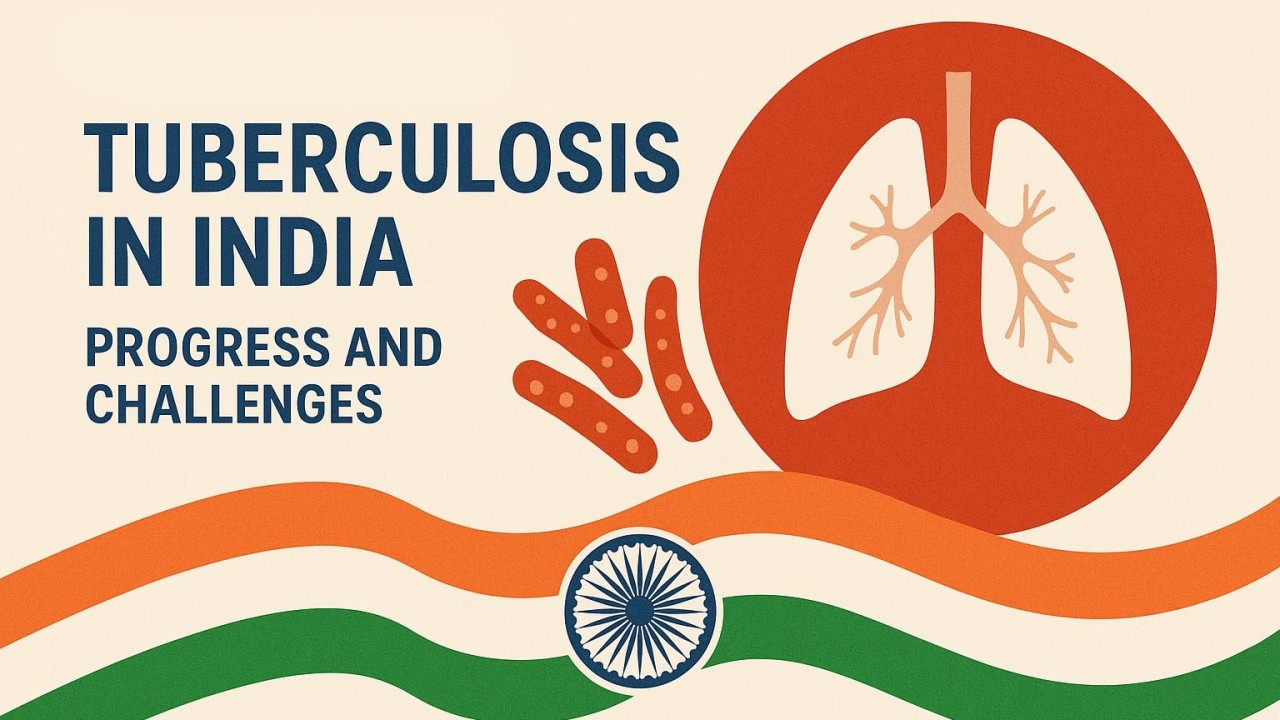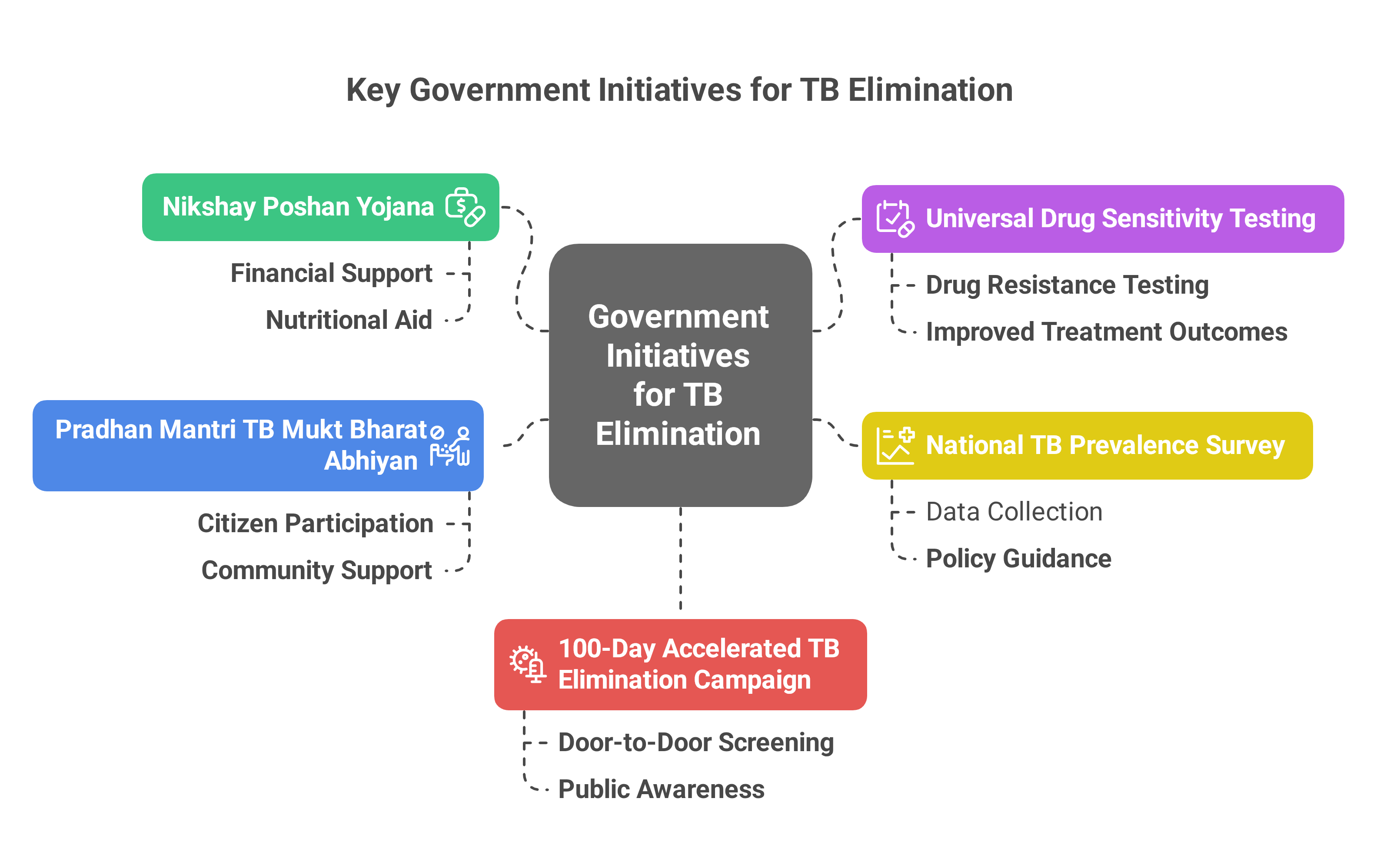Context
Tuberculosis (TB) continues to be one of India’s most serious public health challenges. Despite being preventable and curable, TB still affects millions of people each year. India aims to eliminate TB by 2025, five years ahead of the global Sustainable Development Goal (SDG) target of 2030.
In 2020, the Revised National TB Control Programme (RNTCP) was renamed the National TB Elimination Programme (NTEP) to reflect this ambition. The SDG targets for TB, using 2015 as the baseline, include:
- 80% reduction in TB incidence
- 90% reduction in TB mortality
- Zero TB patients and their households facing catastrophic costs
The current leadership has made TB elimination a national priority. His review of NTEP has underscored public participation, innovation, and scaling up proven strategies.
India’s TB Burden and Progress:
India accounts for nearly 27% of global TB cases. According to the WHO’s Global TB Report 2023:
- Estimated incidence: 2.82 million new TB cases in 2022 (199 per 100,000 population)
- Estimated mortality: 331,000 deaths (23 per 100,000)
- 2% of TB patients are HIV positive
- Drug-resistant TB (DR-TB): 2.5% in new cases and 13% in previously treated cases
Between 2015 and 2022, TB incidence declined by 16% and deaths by 18% — a pace faster than the global average.
Strategic Framework: Detect – Treat – Prevent – Build
India’s approach is guided by the National Strategic Plan (2017–2025) under four pillars:
- Detect: Early diagnosis, including in asymptomatic patients
- Treat: Prompt treatment with quality-assured drugs
- Prevent: Contact tracing, preventive treatment, and airborne infection control
- Build: Multi-sectoral responses to address social determinants
Diagnostic Advances
Timely diagnosis remains the most critical weak link. India has scaled up diagnostic infrastructure significantly:
- 1.89 crore sputum smear tests and 68.3 lakh nucleic acid amplification tests (NAAT) conducted in 2023
- Designated Microscopy Centres grew by 80% (from 13,583 in 2014 to 24,573 in 2023)
- 6,496 molecular diagnostic laboratories and 81 Culture and Drug Susceptibility Testing labs established
India’s 100-day Intensified TB Mukt Bharat Abhiyaan demonstrated the power of proactive screening. Out of 7.19 lakh cases detected, 2.85 lakh were asymptomatic. Portable chest X-rays and AI-assisted readings helped identify cases that would have been missed under symptom-based screening.
Non-invasive sampling methods like tongue and nasal swabs, along with open PCR platforms, are also emerging as low-cost, effective diagnostic tools.
Treatment and Differentiated Care
India provides free, comprehensive care for TB patients. In 2023 alone, 25.5 lakh TB cases were notified, higher than pre-COVID levels. The treatment success rate improved to 87.6% in 2023, despite one-third of patients coming from the private sector.
Key achievements include:
- 792 DR-TB treatment centres functional
- Introduction of shorter oral regimens for DR-TB
- Emphasis on comorbidity management for malnutrition, diabetes, HIV, and substance abuse
- Differentiated TB care model, ensuring early risk assessment and timely referral for severe cases
Prevention and Patient Support:
Preventing TB among vulnerable populations is a priority. The Government released guidelines for TB Preventive Treatment (TPT) in 2021.
To tackle undernutrition, the Nikshay Poshan Yojana provides ₹500 per month per patient as direct benefit transfer. Cumulatively, ₹2,781 crore has been disbursed to nearly 1 crore beneficiaries.
Other initiatives include:
- Incentives for treatment supporters, ASHA workers, and TB champions
- Ni-kshay Saathi (family caregiver) model to enhance community support
Community Participation: PMTBMBA
The Pradhan Mantri TB Mukt Bharat Abhiyaan (PMTBMBA) was launched on 9 September 2022 to augment community involvement and leverage CSR support.
As of July 2024:
- Over 1.6 lakh Nikshay Mitras have registered
- Linked to 11.4 lakh TB patients
- 18 lakh support kits distributed
Prominent leaders — Governors, Chief Ministers, Union Ministers, and local officials — have personally adopted patients.
Private Sector Engagement and Active Case Finding
Private sector engagement has grown significantly. Private notifications increased more than seven times over eight years. In 2022 and 2023 alone, 7.33 lakh and 8.44 lakh cases were notified by private providers, comprising 30–33% of all cases.
Active case finding among high-risk groups — including people living with HIV, diabetics, prisoners, tribal communities, and the undernourished — has led to detection of an additional 3 lakh cases since inception.
Medical Colleges: Strengthening Academic and Clinical Efforts
About 560 of 645 medical colleges collaborate with NTEP by operating TB detection and treatment centres, DR-TB centres, and laboratories.
The Medical College Task Force Mechanism coordinates activities through:
- National Task Force (NTF)
- Zonal Task Forces (ZTF)
- State Task Forces (STF)
These groups meet regularly to review progress in treatment, training, and research.
Innovation and the Promise of a TB Vaccine
While diagnostics and treatment improvements are crucial, a long-term solution depends on a TB vaccine. Inspired by COVID-19 vaccine development, India is working on several candidates, including mRNA-based vaccines in early trials.
With its scientific capacity and manufacturing infrastructure, India is uniquely positioned to lead in vaccine development and distribution.
Conclusion
India has made remarkable progress in reducing TB burden, improving case detection, engaging the private sector, and supporting patients. Yet significant challenges remain:
- The diagnostic gap, especially for subclinical TB
- High burden of drug-resistant TB
- Social determinants like undernutrition and poverty
Sustained political commitment, strong community engagement, and innovation are vital. By scaling up AI-enabled diagnostics, strengthening differentiated care, and accelerating vaccine development, India can move closer to eliminating TB by 2025 and set an example for the world.
With continued focus and investment, India can transform its TB elimination vision into reality, ensuring no patient is left behind.
| Main question: India has set an ambitious target of eliminating tuberculosis by 2025, five years ahead of the global goal. Discuss the main strategies adopted under the National TB Elimination Programme (NTEP) to achieve this target. What challenges remain in bridging the diagnostic and treatment gaps? |








